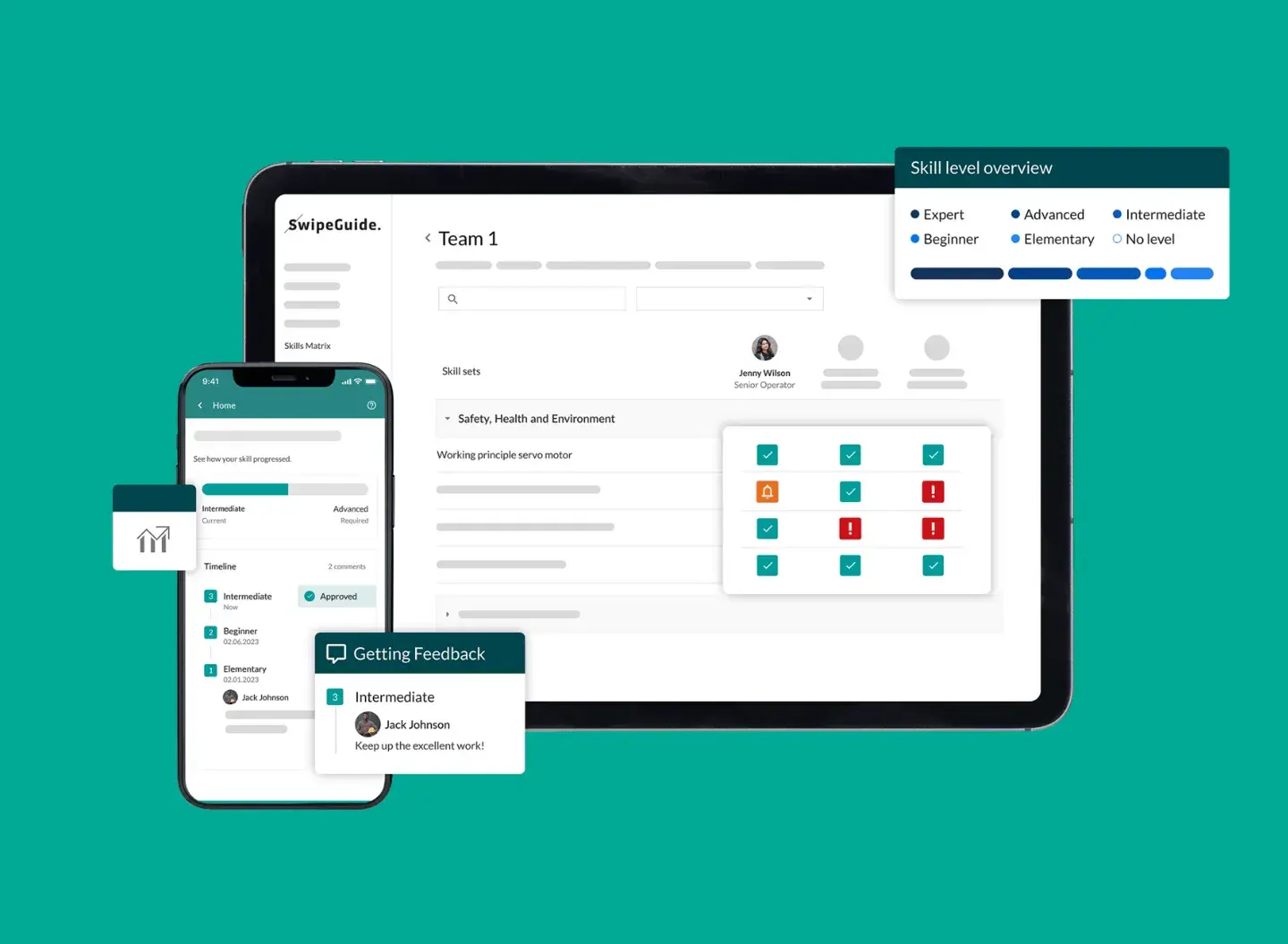Why is data visualization important?
- Helps people see, interact with, and better understand data.
- The human eye is drawn to colors and patterns.
- We can quickly see trends and outliers.
- Storytelling with a purpose.
- Taking immediate action based on data to create more impact.
0. Set up a solid strategy.
Before doing anything else, make sure that you know what to look at.
A senior manager at PepsiCo suggests the following structure when getting started with Lean 5S setup for continuously improving standard work: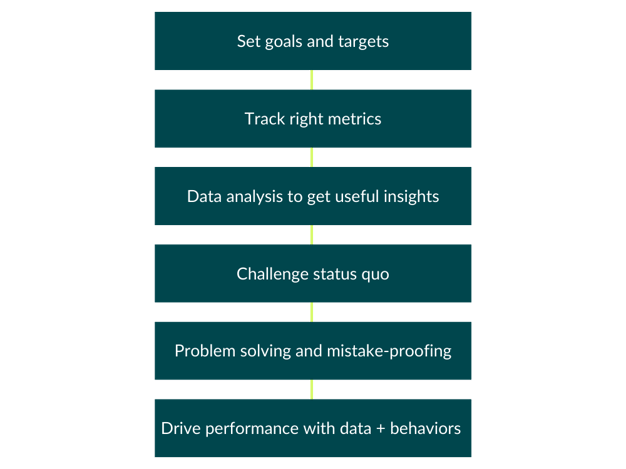
1. Define and create the standards.
Standard work and checklists build the base of what can be the expected outcome of a process. Without a base, it's difficult to know what data or improvements to focus on.
DeLaval chose SwipeGuide for their instructions and checklist in order to focus more on the operator experience. The clarity in task definition ensures access to required information at point of use on tablets, mobile phones, and wearable devices.
"Successfully setting up digital standards starts with proper training", says a Production System Manager at DeLaval.
This is how they create standards:
- Internal training for production leaders on how to create standard work.
- Validation process by production engineers and managers.
- Clear audit structures with recurring intervals.
- Clear and practical handover from engineers and managers to operators on how to use the instructions and checklists in SwipeGuide.
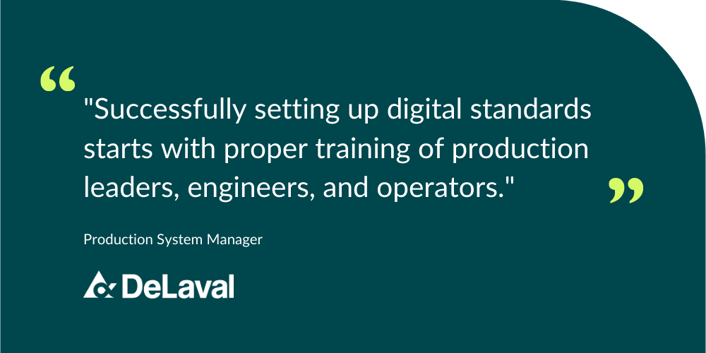
2. Collect data and collaborate to improve.
Data collection is an essential step in this process - as it allows teams to identify problem areas, track usage, and ultimately improve the creation and adherence to standards.
SwipeGuide customers use our checklists feature to collect operational data, but also gain insights into task execution and how frontline teams are using work instructions.
Examples of data points captured by checklists:
- Task execution and completion
- Safety, quality, cleaning, and 5s
- Completion rates
- Deviations
After this data collection, it's time to start improving. A Process and Data Manager at ofi suggests that in order to keep track of progress, you should make sure to involve and collaborate with various departments.
In production, this could be a collaboration between the following teams:
This makes it easier to capture information and data from various subject matter experts of different domains in order to define and execute improvements based on the right insights.
With this setup, ofi has been able to identify requirements that will help them capture the right domain knowledge across teams, lines, and sites.
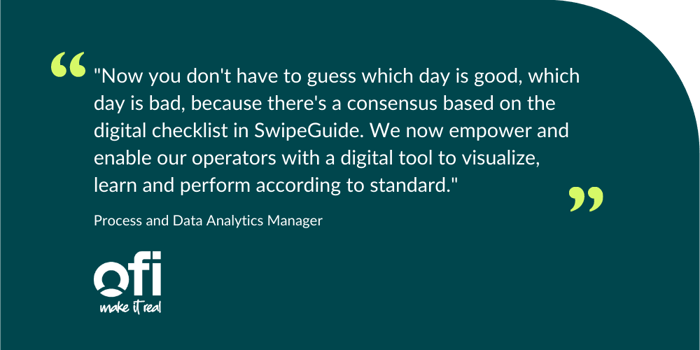
3. Analyzing the data for continuous improvement in manufacturing.
Connecting the data from your SwipeGuide instructions, SOPs, and checklist with data visualization tools (like Tableau and PowerBi) takes your manufacturing data analysis and problem solving to the next level.
.png?width=518&height=259&name=Tableau%20+%20Power%20Bi%20+%20SwipeGuide%20(1000%20%C3%97%20500%20px).png)
Here are some manufacturing data analysis best practices from ofi for working in Tableau:
- Choose the right graph type with effective view (eg. line graph over time) with holistic, visual, and easy to understand dashboards.
- Focus on visibility and easy use by operators on the shop floor to give them clear insights on the progress.
- Keep track of checks in SwipeGuide and collect feedback from operators to empower them and improve processes.
- Contextualize the data with Power BI.
- Extract data into a dashboard and evaluate against target in Tableau.
By using this methodology, ofi is able to capture information and generating value, make operations safer, products better - and improve overall machine conditions (OEE) from 55% to 99.69%.
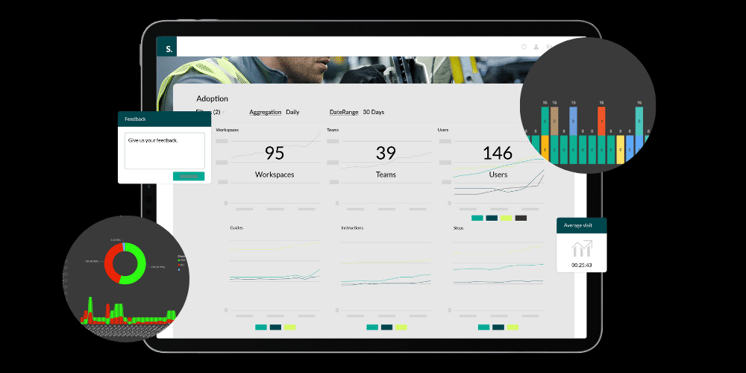
And here's a similar set of best practices for working with PowerBi:
This setup is used at PepsiCo to further analyze data captured in SwipeGuide across manufacturing operations:
- Measure compliance with SwipeGuide checklists (Gemba style)
- Data capture in SwipeGuide.
- Export as .csv file to transform and filter data.
- Upload to Power BI.
- Generate a report in Power BI to get in-depth insights on governance improvements and escalation of recurring issues.
- Publish data visualization to tablets in governance rules rooms so everyone can view it, also operators.
- Discuss outcomes in hourly, daily, weekly, and monthly meetings and include in escalation process.
Next step: continuous improvement.
In this article, I've highlighted a couple of use cases where SwipeGuide users utilize data (from checklists, instructions, and SOPs) and connect it with external data visualization and analysis tools.
- Use data to understand the variance over time and act based on alerts.
- Track what problems occur compared to the standard of a team/line/station/site.
- Address the problem and validate if it's caused by behavior or governance.
- And equally important: address what's going well and reward success.
These tools will allow you to harness the power of data analytics in manufacturing order to continuously improve, day in and day out.
Curious to hear more?
Schedule a call with us.
Learn more:
👉 Knowledge + data analytics for manufacturing.
👉 The Future Factory is Built on Data. Future-Proof Your Operations.
👉 How to Efficiently Reduce Errors and Downtime in Manufacturing







.png?width=518&height=259&name=Tableau%20+%20Power%20Bi%20+%20SwipeGuide%20(1000%20%C3%97%20500%20px).png)



